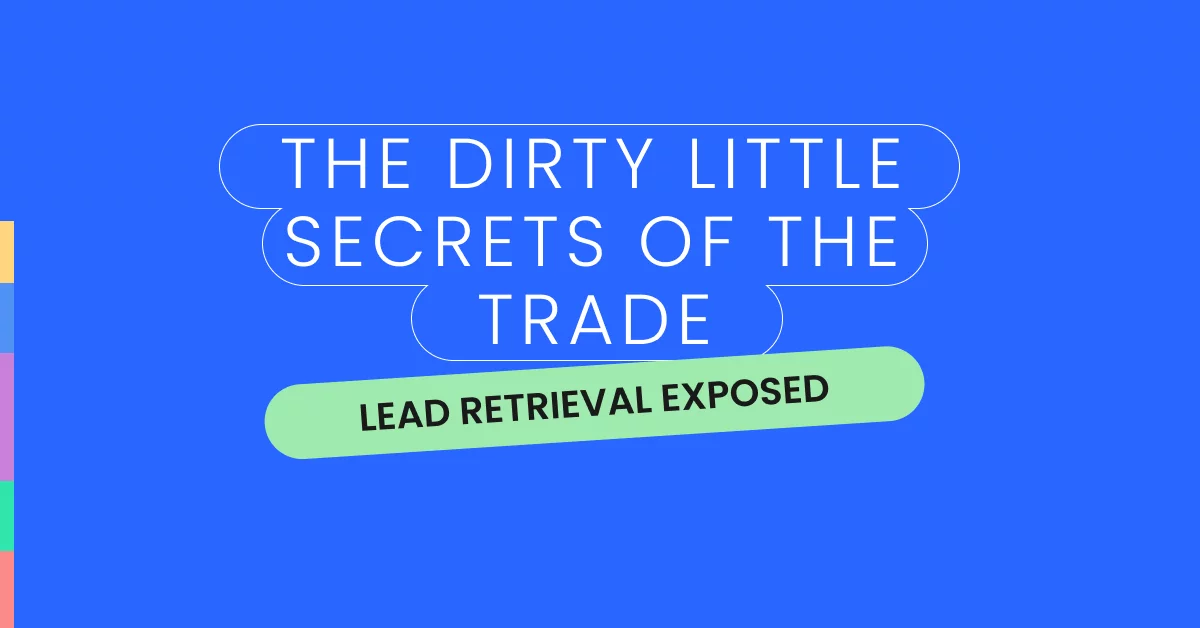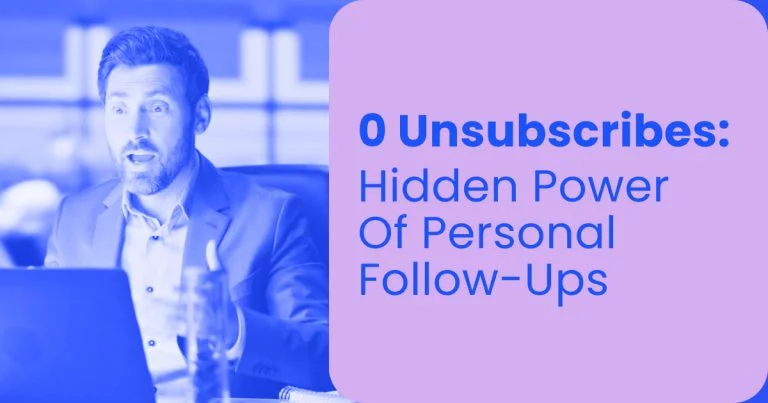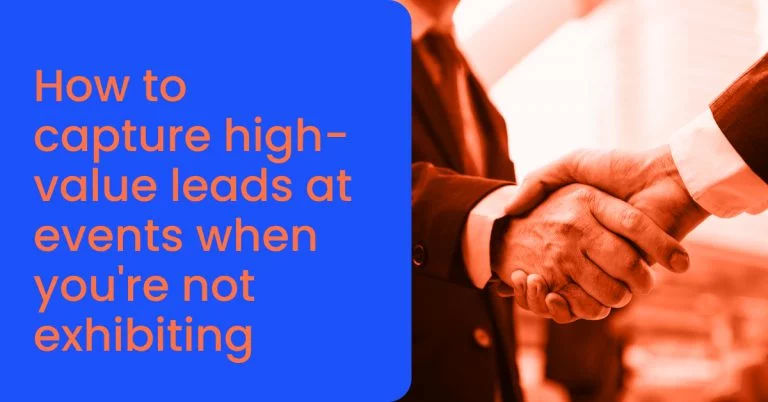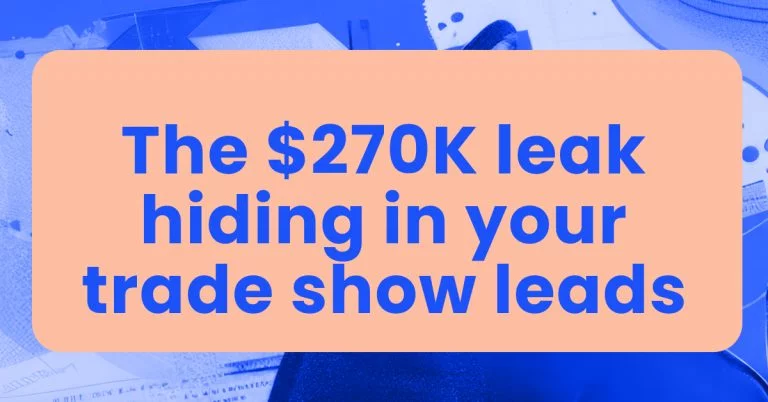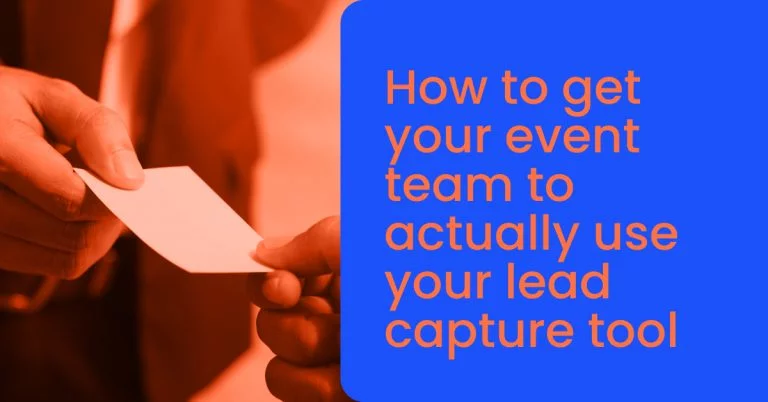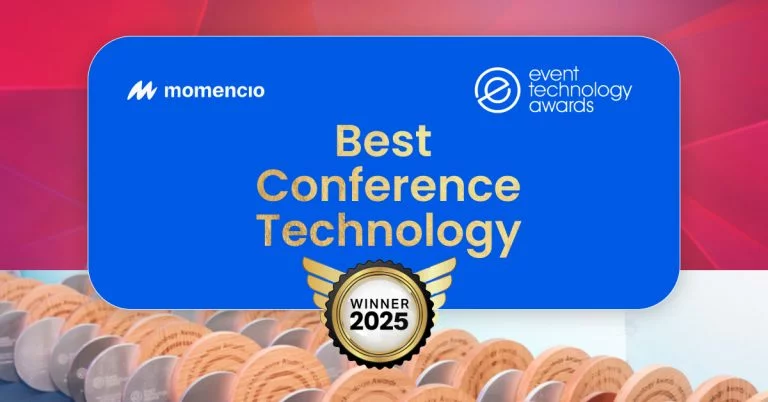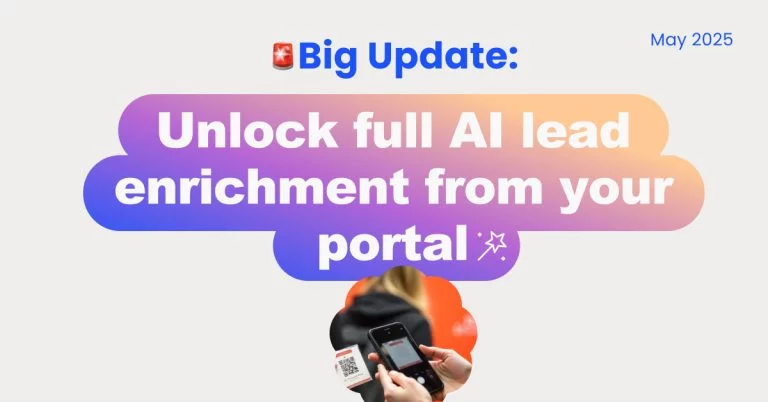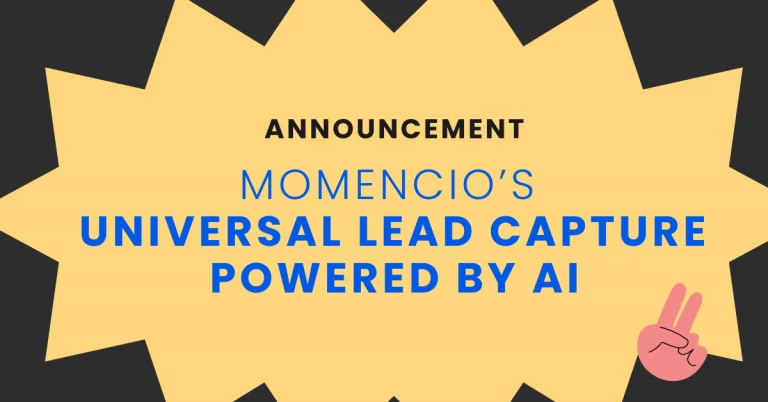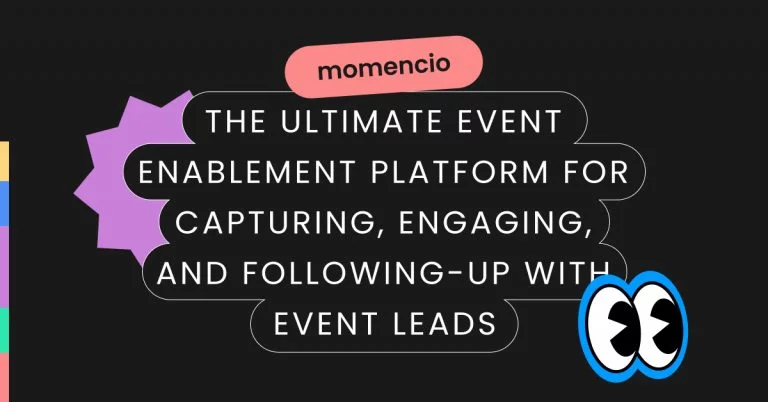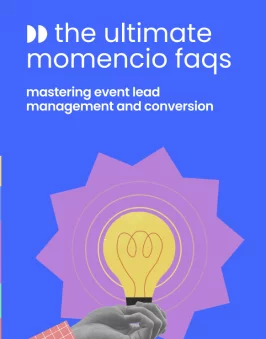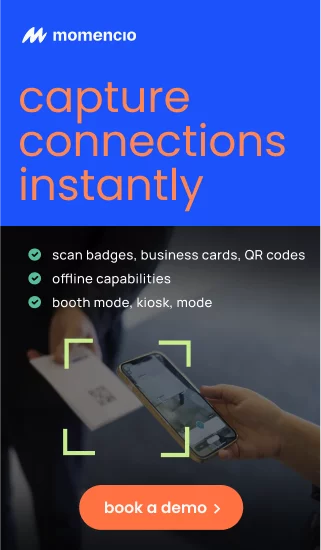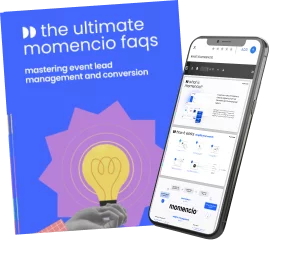Lead retrieval has become a cornerstone of modern event marketing, promising to turn booth interactions into meaningful business opportunities. Yet, despite the growing sophistication of lead retrieval systems, many businesses find themselves grappling with unmet expectations, incomplete data, and poor ROI. Did you know that 79% of event leads fail to convert into sales due to issues like lack of follow-up or poor data quality?
These statistics paint a stark picture for event planners, exhibitors, and marketers who rely on these tools to justify event investments. Hidden fees, misleading claims, and the automation trap further complicate the landscape, leaving companies frustrated and struggling to optimize their processes.
This article uncovers the hidden pitfalls of lead retrieval systems and explores actionable strategies to overcome them. From tackling misleading promises to prioritizing lead quality over quantity, we’ll help you navigate this complex terrain and ensure every lead captured becomes a step toward ROI success.
The misleading promises of lead retrieval systems
Lead retrieval systems are often marketed as the ultimate solution for turning event interactions into qualified leads, promising seamless CRM integration, automated follow-ups, and high conversion rates. While these claims are enticing, the reality often falls short, leaving businesses disillusioned and unable to achieve the ROI they envisioned.
Overpromising and under-delivering
Many vendors claim their tools will effortlessly integrate with existing CRM systems or marketing platforms. However, in practice, integration issues are widespread. A report by Salesforce reveals that 66% of marketers struggle to unify lead data across platforms, leading to fragmented insights and inefficiencies. Without proper synchronization, even the most sophisticated lead retrieval tools fail to deliver actionable outcomes.
In addition, many systems boast “automation” but often require extensive manual configuration. From setting up workflows to tagging leads appropriately, the process can be time-intensive and prone to errors if the team isn’t adequately trained.
The lack of actionable insights
Another common promise is that these tools will provide deep insights into attendee behavior and preferences. However, most systems stop at basic contact information, leaving teams to piece together engagement histories manually. This lack of depth hampers personalized follow-up efforts, which are critical for conversion.
Red flags to watch out for
To avoid falling victim to misleading claims, businesses should:
- Request a demonstration: Insist on seeing the tool in action, focusing on CRM integration and data reporting capabilities.
- Verify compatibility: Ensure the system integrates with your existing platforms without the need for excessive customization.
- Ask for case studies: Look for success stories from companies in your industry to validate the tool’s effectiveness.
- Evaluate support: Assess whether the vendor offers ongoing support and training for your team.
Pro tip: align tools with event goals
Instead of focusing solely on features, choose a lead retrieval system that aligns with your event objectives. Whether your priority is high-volume lead collection, detailed behavioral insights, or post-event follow-ups, tailor your tool selection accordingly.
By recognizing the gaps between promises and actual performance, you can make informed decisions that prevent wasted investments and maximize event ROI.
Understanding the data trap: From collection to conversion
Lead retrieval tools are designed to simplify data collection, yet many companies fall into the “data trap”—a scenario where leads are captured in abundance but fail to translate into meaningful results. The problem isn’t just in capturing the data but in how that data is processed, managed, and utilized.
Incomplete contact details: a missed opportunity
One of the most common issues in lead retrieval is incomplete or inaccurate data. At high-traffic events, staff often rush to scan badges or collect business cards, resulting in missing or incorrect details. A study found that 45% of collected event leads are unusable due to incomplete or poorly formatted data.
Generic data collection methods
Many systems fail to go beyond surface-level data, such as name and email. While this information is essential, it doesn’t provide insights into a lead’s interests or intent. Without personalized context, follow-up communication can feel generic and impersonal, reducing the likelihood of engagement.
The absence of a post-event strategy
Another major pitfall is the lack of a clear post-event follow-up plan. Businesses often assume that capturing leads is the hardest part, but without timely and relevant follow-ups, even the most promising leads can go cold. A report by HubSpot reveals that companies that follow up within five minutes of lead capture are 21 times more likely to qualify the lead.
Breaking out of the trap
Here’s how businesses can avoid the data trap and convert their leads effectively:
- Prioritize data enrichment: Use tools that allow for additional notes and context to be added during lead capture. Platforms offering features like instant note-taking or interactive surveys can help.
- Segment leads immediately: Organize leads based on engagement level or specific interests during the event. Tools with built-in segmentation capabilities streamline this process.
- Develop a follow-up framework: Plan a follow-up strategy before the event begins, incorporating personalized email templates and scheduling touchpoints based on lead behavior.
Leveraging analytics for precision
Data analytics can be a game-changer in the conversion process. Platforms offering real-time dashboards and behavioral insights allow businesses to prioritize leads that show higher engagement levels. For example, tracking whether a lead opened your follow-up email or visited a landing page can signal interest and help refine your approach.
By addressing these common pitfalls, companies can transform raw data into actionable insights, creating a seamless path from collection to conversion.
Pay-to-play—Are event organizers putting profits over performance?
In the world of events and trade shows, exhibitors often rely on proprietary lead retrieval systems provided by event organizers. While these systems promise convenience and compatibility with the event’s setup, they often come with significant drawbacks, leading to a frustrating “pay-to-play” dynamic that prioritizes organizer profits over exhibitor needs.
The problem with proprietary systems
Event organizers frequently require exhibitors to use their in-house lead retrieval tools, which may not integrate well with external CRMs or marketing automation platforms. These systems often restrict how and when data is accessed, making it difficult for exhibitors to act on leads promptly.
Additionally, proprietary systems are usually designed with the organizer’s revenue in mind rather than the exhibitor’s ROI. This can result in tools that are expensive but lack advanced features like real-time analytics, detailed lead segmentation, or customizable follow-ups.
Data ownership dilemmas
In some cases, event organizers retain partial ownership of the collected data, limiting the exhibitor’s access. This raises concerns about data privacy and can delay post-event lead nurturing efforts. According to a report, 39% of exhibitors expressed dissatisfaction with lead retrieval systems due to data accessibility issues.
Hidden fees add up
Many exhibitors are blindsided by unexpected fees associated with these systems, including:
- Export fees: Extra charges to download or access collected leads post-event.
- Additional licenses: Costs for adding team members or accessing advanced features.
- Data transfer costs: Fees for integrating data with external systems.
These hidden costs can inflate budgets significantly. For example, a study by Exhibitor Magazine found that nearly 25% of exhibitors spend more on lead retrieval than initially planned due to these unforeseen charges.
How to push back against the pay-to-play model
Exhibitors can take proactive steps to minimize the impact of restrictive lead retrieval systems:
- Negotiate terms: Before committing to an event, discuss lead retrieval policies with the organizer. Request clarity on data access, ownership, and additional fees.
- Opt for third-party tools: Some events allow exhibitors to use independent lead retrieval systems. Choose tools that integrate seamlessly with your existing CRM and marketing stack.
- Budget for extras: If proprietary systems are unavoidable, allocate part of your budget for potential add-ons or export fees.
- Leverage multi-event tools: Invest in a lead retrieval platform that works across multiple events, reducing reliance on event-specific systems and ensuring consistent data access.
Transparency is key
Event organizers must recognize the need for greater transparency in their lead retrieval practices. Exhibitors should demand systems that prioritize functionality and value, ensuring that their investments in events lead to tangible ROI.
By understanding the limitations of the pay-to-play model and advocating for better solutions, exhibitors can make informed decisions that enhance their lead management processes while avoiding unnecessary expenses.
Unveiling hidden costs in lead retrieval services
At first glance, lead retrieval services may seem straightforward: capture attendee information, access it post-event, and begin the follow-up process. However, many companies encounter hidden fees that inflate costs and strain budgets, leading to frustration and diminished ROI.
Common hidden costs to watch for
- Data export fees
Many lead retrieval providers charge additional fees to access or export captured data. Exhibitors often assume they own the data they collect, only to find themselves paying premium fees to download attendee lists or integrate the information with their CRM.
Example: A mid-sized exhibitor at a trade show may be charged $500 or more just to export lead details post-event, which wasn’t disclosed upfront.
- Licensing fees
Some tools require separate licenses for each user, making it costly for larger teams to access the system. This fee structure can be particularly prohibitive for exhibitors with multiple staff managing leads. - Advanced feature charges
Features like real-time analytics, automated follow-ups, or advanced segmentation are often locked behind paywalls. Exhibitors expecting full functionality may find themselves paying significantly more to unlock these essential tools. - Integration costs
While many systems advertise CRM compatibility, they often require custom integrations, which come at an extra cost. These fees can range from a few hundred to thousands of dollars, depending on the complexity of the integration. - Data retention fees
Some providers charge additional fees to retain lead data beyond a certain timeframe. If companies need to revisit older leads, they may find the data inaccessible without paying a renewal or storage fee.
The impact of hidden costs
Hidden fees can erode trust and lead to a poor exhibitor experience. A study found that 34% of exhibitors encountered unexpected expenses related to lead retrieval services, with nearly 20% stating these costs negatively impacted their event budget.
Moreover, these costs can reduce the overall ROI of event participation, as funds intended for lead nurturing and marketing are instead diverted to unplanned expenses.
How to avoid hidden costs
- Read the fine print
Always review contracts and terms of service before committing to a lead retrieval provider. Look for clauses detailing data access, licensing, and additional feature costs. - Ask direct questions
During the negotiation process, ask providers for a detailed breakdown of potential fees, including export costs, user licenses, and data storage. - Opt for transparent tools
Choose providers known for their clear pricing structures. Many third-party lead retrieval platforms emphasize transparency as a key selling point. - Prioritize integration
Select systems that offer seamless integration with your existing CRM or marketing automation tools without the need for custom development.
Pro tip: look for all-inclusive pricing
Some lead retrieval tools offer all-inclusive packages that cover export fees, advanced features, and multiple user licenses. While the upfront cost may be higher, these packages often provide better value in the long run.
Hidden costs are an unfortunate reality of many lead retrieval services, but by proactively addressing potential expenses, companies can better manage their budgets and ensure that their investment in lead retrieval yields meaningful results.
The automation illusion—why strategy matters more than systems
The promise of automation in lead retrieval is alluring: a tool that effortlessly captures, organizes, and nurtures leads without human intervention. However, the reality is far more complex. Automation is a valuable component of lead management, but it requires strategic oversight, training, and active engagement to deliver results.
The myth of “set-it-and-forget-it”
Lead retrieval tools often market themselves as fully automated solutions. While automation can simplify repetitive tasks like data collection or email triggers, it is not a substitute for human involvement. A survey by McKinsey found that 40% of businesses implementing automation expected reduced workloads but later reported inefficiencies due to improper execution.
Automated systems can fall short in areas such as:
- Contextual follow-ups: Automated responses can feel generic, failing to address specific attendee interests or needs.
- Lead prioritization: Without manual oversight, automation may assign equal weight to all leads, missing high-priority opportunities.
- Error handling: Systems cannot account for nuances like correcting misspelled names or clarifying ambiguous job titles.
Why strategy is essential
Automation tools amplify the results of a well-thought-out strategy; they cannot replace it. Successful lead retrieval hinges on aligning the technology with your event goals and sales processes.
- Pre-event planning
Map out how automation will support your goals. For example, if the objective is to book post-event meetings, ensure automated follow-ups include calendar links and personalized messages based on attendee interactions. - Active engagement during the event
Automation cannot replace the human touch required for meaningful conversations. Train booth staff to use the lead retrieval system effectively, ensuring they log critical details like specific interests or product inquiries. These insights are invaluable for tailoring follow-ups. - Post-event execution
Develop a framework that combines automation with manual effort. For instance:- Use automation to send an immediate thank-you email after lead capture.
- Assign a sales representative to follow up personally with high-priority leads.
Overcoming automation pitfalls
To avoid common automation traps, consider the following:
- Combine technology with training: Ensure your team understands how to use the lead retrieval tool effectively and integrates it into their workflow.
- Customize responses: Create a library of personalized email templates tailored to different attendee segments or interactions.
- Regularly audit data: Review captured leads to correct errors and enhance profiles with missing information.
- Monitor performance: Use analytics dashboards to track the success of automated actions and refine workflows based on results.
Real-world success: blending automation and strategy
A technology exhibitor at a major trade show combined automated lead retrieval with strategic follow-ups. The tool sent personalized emails to all leads within two hours, but high-value leads were flagged for manual follow-up by the sales team. This dual approach led to a 35% increase in post-event meetings and a 20% rise in conversions compared to the previous year.
Pro tip: leverage AI for smarter automation
Modern lead retrieval tools equipped with AI can analyze lead behavior and suggest optimal follow-up actions. However, even these advanced systems require human input to align insights with business objectives.
The automation illusion can derail even the best lead retrieval efforts. By recognizing its limitations and embedding it within a robust strategy, companies can harness its potential to drive measurable results.
Quality over quantity—The case for better lead qualification
When it comes to lead retrieval, many exhibitors equate success with the sheer number of leads collected. However, prioritizing quantity over quality often results in wasted resources, poor ROI, and a frustrated sales team. In fact, a Salesforce study found that 61% of marketers believe lead quality is the single most important factor in achieving sales success.
The pitfalls of prioritizing quantity
- Overwhelmed sales teams: A flood of unqualified leads can overwhelm sales teams, forcing them to sift through low-potential contacts while missing high-value prospects.
- Wasted resources: Following up on irrelevant leads wastes time, money, and energy that could be better spent on more promising opportunities.
- Low conversion rates: High volumes of poorly qualified leads often result in dismal conversion rates, making it harder to justify event expenses.
What defines a high-quality lead?
A high-quality lead is not just someone who stopped by your booth; it’s an individual or company that aligns with your target audience, demonstrates genuine interest, and has potential to convert into a customer. Key indicators of a quality lead include:
- Job title or decision-making authority.
- Clear interest in your product or service (e.g., questions asked, materials downloaded).
- Alignment with your ideal customer profile (ICP).
How faulty lead retrieval systems hinder quality
Many lead retrieval systems fail to filter or qualify leads effectively. They capture basic information like names and email addresses but lack features for scoring or categorizing leads based on engagement or fit. Without this critical context, sales teams are left guessing which leads are worth pursuing.
Strategies for better lead qualification
- Leverage lead scoring
Implement systems that assign scores to leads based on predefined criteria, such as level of engagement, company size, or budget potential. Higher scores indicate better alignment with your ICP. - Capture context during events
Encourage booth staff to collect contextual data during interactions, such as specific interests, challenges, or buying timelines. Use tools that allow for real-time note-taking or tagging. - Segment leads immediately
Segment leads into categories like hot, warm, and cold based on their likelihood to convert. This segmentation ensures high-priority leads receive immediate attention. - Enhance qualification with surveys
Incorporate interactive surveys or polls into your booth experience. These not only engage attendees but also provide valuable data about their preferences and readiness to buy. - Use analytics to refine qualification
Post-event analytics can reveal patterns in lead behavior, such as which attendees opened follow-up emails or visited your website. Use these insights to adjust your qualification criteria for future events.
Pro tip: invest in smart tools
Modern lead retrieval platforms equipped with AI and CRM integration can help qualify leads in real time. For example, momencio offers advanced lead scoring capabilities and analytics that streamline the process of identifying high-quality prospects.
Why quality outweighs quantity
A case study from HubSpot demonstrates the value of prioritizing quality: a B2B software company reduced its lead volume by 20% but saw a 30% increase in sales. By focusing on high-quality leads, the company was able to allocate resources more effectively, resulting in better ROI and faster deal closures.
Shifting the focus
By moving from a “collect-everything” mentality to a targeted approach, businesses can maximize the impact of their lead retrieval efforts. High-quality leads don’t just improve conversion rates—they build stronger customer relationships and create a foundation for long-term success.
Conclusion
Lead retrieval is an essential component of any event marketing strategy, but it is also fraught with challenges that can undermine its effectiveness. From misleading promises and hidden costs to the pitfalls of automation and the quality-versus-quantity dilemma, navigating the lead retrieval process requires both strategic foresight and the right tools.
To make lead retrieval work for your business, focus on these key principles:
- Demand transparency: Choose systems with clear pricing and policies to avoid unexpected fees or data access restrictions.
- Prioritize CRM integration: Ensure that your lead retrieval platform seamlessly integrates with your CRM and marketing automation tools, making it easier to track, manage, and act on leads.
- Invest in training and strategy: Equip your team with the skills to use the system effectively and align their efforts with your broader sales and marketing goals.
- Focus on lead quality: Use lead scoring, segmentation, and contextual data capture to identify and nurture high-potential prospects.
By addressing these issues head-on, businesses can transform lead retrieval from a frustrating bottleneck into a powerful driver of event ROI.
Choosing the right lead retrieval platform is critical. Modern tools like momencio not only capture leads efficiently but also provide the analytics and integrations needed to maximize conversion rates. With features such as real-time lead scoring, post-event follow-up automation, and seamless CRM compatibility, momencio simplifies the entire lead management process, enabling you to focus on building meaningful customer relationships.
FAQs
- What is lead retrieval, and why is it important?
- Lead retrieval is the process of capturing, managing, and nurturing potential customer information during events such as trade shows, conferences, and exhibitions. It plays a crucial role in converting event interactions into actionable sales opportunities. By ensuring that no lead is overlooked and that collected data is well-organized for follow-up and analysis, lead retrieval helps businesses maximize their ROI and improve overall event success.
- How do I choose the right lead retrieval system?
- Choosing the right lead retrieval system requires evaluating its compatibility with your business needs. Focus on CRM integration to ensure seamless data transfer to your existing platforms. Transparency in pricing is also important, as it helps avoid hidden fees. Look for systems with advanced features such as lead scoring, segmentation, and real-time analytics, as these can significantly enhance your ability to prioritize and act on leads. Additionally, the platform should be user-friendly and flexible enough to work across multiple events and environments.
- What are the most common pitfalls of lead retrieval?
- One of the biggest pitfalls is relying on systems that prioritize quantity over quality, which can lead to wasted resources and low conversion rates. Other common issues include hidden costs, poor integration with CRM systems, and a lack of actionable insights from the collected data. Businesses also often fall into the automation trap, assuming that lead retrieval tools require little oversight, when in fact strategic planning and active engagement are necessary for success.
- How can I ensure effective follow-up after an event?
- Effective follow-up begins with organizing your leads immediately after the event. Segment your leads based on priority and tailor your communication to their specific needs and interests. Utilize automation tools to send timely and personalized emails, but ensure high-priority leads receive direct attention from your sales team. Real-time analytics can help track engagement and refine your follow-up approach, making it more targeted and impactful.
- What should I look out for to avoid hidden costs in lead retrieval services?
- To avoid hidden costs, carefully review the pricing terms of the lead retrieval service. Common hidden fees include charges for exporting data, additional licenses, and advanced features like analytics or integration with CRMs. Asking detailed questions about these potential expenses before committing to a service can help mitigate unexpected costs. Additionally, some providers offer all-inclusive pricing packages, which may provide better value over time.
